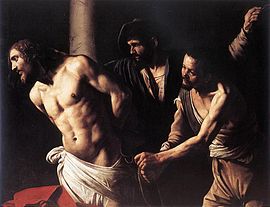art.wikisort.org - Painting
Christ at the Column (also known as The Flagellation of Christ; c. 1606/1607), is a painting by the Italian Baroque painter Caravaggio, now in the Musée des Beaux-Arts de Rouen, Rouen, France.
| Christ at the Column | |
|---|---|
| Italian: Flagellazione | |
 | |
| Artist | Caravaggio |
| Year | c. 1607 |
| Medium | Oil on canvas |
| Dimensions | 134.5 cm × 175.4 cm (53.0 in × 69.1 in) |
| Location | Musée des Beaux Arts, Rouen |
This is one of two versions of the Flagellation of Christ by Caravaggio painted late in 1606 or early in 1607, soon after his arrival in Naples. The painting shows the flagellation of Christ following his arrest and trial and before his crucifixion. The scene was traditionally depicted in front of a column, possibly alluding to the judgement hall of Pilate. The snub-nosed torturer on the far right is recognisably the same figure who modelled as one of the torturers in The Flagellation of Christ, and as the executioner in Salome with the Head of John the Baptist.
The most famous treatment of the theme at the time was Sebastiano del Piombo's High Renaissance Flagellation of Christ in the church of San Pietro in Montorio in Rome. Piombo's Flagellation, much imitated by later artists, shows multiple idealised figures twisting through complex layers of space. Caravaggio has flattened the space, reduced the figures to a minimum, and used light to direct attention to the crucial parts of his composition - Christ's face and torso, the faces of the two torturers, and the hand holding the out-of-frame whip.
See also
- List of paintings by Caravaggio
References
- Gash, John (2004). Caravaggio. ISBN 1-904449-22-0.
- Langdon, Helen (1998). Caravaggio: A Life. ISBN 0-374-11894-9.
- Robb, Peter (1998). M. ISBN 978-0-312-27474-0.
External links
 Media related to Christ at the Column by Caravaggio at Wikimedia Commons
Media related to Christ at the Column by Caravaggio at Wikimedia Commons
На других языках
- [en] Christ at the Column (Caravaggio)
[es] Cristo en la columna (Caravaggio)
Cristo en la columna es un cuadro religioso de Caravaggio, hecho en 1607 y conservado en el Museo de Bellas Artes de Ruan, Francia. No es raro el uso de la tortura como tema en Caravaggio (La coronación de espinas), pues la identificaba con su propia vida. Esta vez, la luz y la crudeza de sus personajes hacen que el pintor logre un cuadro de gran dramatismo.[fr] Le Christ à la colonne (Le Caravage)
Le Christ à la colonne (ou Flagellation du Christ) est un tableau de Caravage peint entre 1606 et 1607 et conservé au Musée des beaux-arts de Rouen. Il représente le Christ sur le point de se faire flageller par deux bourreaux qui l'attachent à une haute colonne, en prélude à sa Passion. L’œuvre, dont l'attribution à Caravage est récente (fin des années 1950) n'est pas datée de façon certaine mais les historiens de l'art s'accordent à la rattacher à la période du tout premier séjour du peintre à Naples, alors qu'il vient de s'enfuir de Rome où il a commis un meurtre. Typique de la manière caravagesque, le Christ à la colonne offre une composition originale qui est étonnamment différente de celle choisie pour une seconde Flagellation que Caravage réalise à très peu de temps d'écart pour une église napolitaine.[it] Flagellazione di Cristo (Caravaggio Rouen)
La Flagellazione di Cristo è un dipinto a olio su tela di 134,5x175,5 cm, realizzato tra il 1606 e il 1607 dal pittore italiano Caravaggio. È conservato nel Musée des Beaux-Arts a Rouen.[ru] Христос у колонны
«Христос у колонны» (англ. Christ at the Column, другой вариант - Бичевание Христа ; около 1606/1607) — картина итальянского художника эпохи барокко Караваджо, которая сейчас находится в Музее изящных искусств в Руане.Другой контент может иметь иную лицензию. Перед использованием материалов сайта WikiSort.org внимательно изучите правила лицензирования конкретных элементов наполнения сайта.
WikiSort.org - проект по пересортировке и дополнению контента Википедии